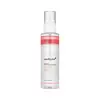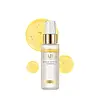What's inside
What's inside
 Key Ingredients
Key Ingredients

 Benefits
Benefits

 Concerns
Concerns

 Ingredients Side-by-side
Ingredients Side-by-side

Water
Skin ConditioningCollagen Water
HumectantDipropylene Glycol
HumectantC13-15 Alkane
SolventRicinus Communis Seed Oil
MaskingGlycereth-26
Humectant1,2-Hexanediol
Skin ConditioningNiacinamide
SmoothingSodium Chloride
MaskingSorbitol
HumectantHydroxyethyl Urea
HumectantButylene Glycol
HumectantHelianthus Annuus Seed Oil
EmollientParfum
MaskingEthylhexylglycerin
Skin ConditioningEclipta Prostrata Extract
Skin ConditioningAdenosine
Skin ConditioningSodium Dna
Skin ConditioningMelia Azadirachta Leaf Extract
Skin ConditioningGlutathione
Paeonia Lactiflora Root Extract
Skin ConditioningMoringa Oleifera Seed Oil
EmollientCandida Bombicola/Glucose/Methyl Rapeseedate Ferment
AntimicrobialRosa Damascena Flower Water
MaskingBiotin
AntiseborrhoeicHexapeptide-2
BleachingBiotinoyl Tripeptide-1
Acetyl Hexapeptide-8
HumectantTripeptide-1
Skin ConditioningTripeptide-3
Skin ConditioningMyristoyl Pentapeptide-17
Skin ConditioningHexapeptide-9
Skin ConditioningWater, Collagen Water, Dipropylene Glycol, C13-15 Alkane, Ricinus Communis Seed Oil, Glycereth-26, 1,2-Hexanediol, Niacinamide, Sodium Chloride, Sorbitol, Hydroxyethyl Urea, Butylene Glycol, Helianthus Annuus Seed Oil, Parfum, Ethylhexylglycerin, Eclipta Prostrata Extract, Adenosine, Sodium Dna, Melia Azadirachta Leaf Extract, Glutathione, Paeonia Lactiflora Root Extract, Moringa Oleifera Seed Oil, Candida Bombicola/Glucose/Methyl Rapeseedate Ferment, Rosa Damascena Flower Water, Biotin, Hexapeptide-2, Biotinoyl Tripeptide-1, Acetyl Hexapeptide-8, Tripeptide-1, Tripeptide-3, Myristoyl Pentapeptide-17, Hexapeptide-9
Water
Skin ConditioningDipropylene Glycol
HumectantNeopentyl Glycol Diheptanoate
EmollientGlycereth-26
Humectant1,2-Hexanediol
Skin ConditioningNiacinamide
SmoothingHydroxyethyl Urea
HumectantPersea Gratissima Oil
Skin ConditioningButylene Glycol
HumectantBetaine
HumectantTuber Magnatum Extract
Skin ConditioningGlycerin
HumectantHelianthus Annuus Seed Oil
EmollientSorbitol
HumectantDipotassium Glycyrrhizate
HumectantDisodium EDTA
Tocopheryl Acetate
AntioxidantAdenosine
Skin ConditioningBifida Ferment Lysate
Skin ConditioningGlycine Soja Oil
EmollientSodium Palmitoyl Proline
Skin ConditioningArginine
MaskingBellis Perennis Flower Extract
Skin ConditioningCarbomer
Emulsion StabilisingFreesia Refracta Extract
Skin ConditioningHouttuynia Cordata Extract
Skin ConditioningLeontopodium Alpinum Extract
Skin ConditioningLilium Candidum Flower Extract
Skin ConditioningMorus Alba Bark Extract
Skin ConditioningNelumbo Nucifera Flower Extract
Skin ConditioningPanax Ginseng Root Extract
EmollientSaussurea Involucrata Extract
HumectantPotassium Sorbate
PreservativeAvena Sativa Kernel Extract
AbrasiveHydrolyzed Hyaluronic Acid
HumectantOcimum Basilicum Flower/Leaf/Stem Extract
TonicSalvia Hispanica Seed Extract
EmollientBixa Orellana Seed Oil
EmollientTocopherol
AntioxidantNymphaea Alba Flower Extract
Skin ConditioningParfum
MaskingLinalool
PerfumingHexyl Cinnamal
PerfumingLimonene
PerfumingCitronellol
PerfumingWater, Dipropylene Glycol, Neopentyl Glycol Diheptanoate, Glycereth-26, 1,2-Hexanediol, Niacinamide, Hydroxyethyl Urea, Persea Gratissima Oil, Butylene Glycol, Betaine, Tuber Magnatum Extract, Glycerin, Helianthus Annuus Seed Oil, Sorbitol, Dipotassium Glycyrrhizate, Disodium EDTA, Tocopheryl Acetate, Adenosine, Bifida Ferment Lysate, Glycine Soja Oil, Sodium Palmitoyl Proline, Arginine, Bellis Perennis Flower Extract, Carbomer, Freesia Refracta Extract, Houttuynia Cordata Extract, Leontopodium Alpinum Extract, Lilium Candidum Flower Extract, Morus Alba Bark Extract, Nelumbo Nucifera Flower Extract, Panax Ginseng Root Extract, Saussurea Involucrata Extract, Potassium Sorbate, Avena Sativa Kernel Extract, Hydrolyzed Hyaluronic Acid, Ocimum Basilicum Flower/Leaf/Stem Extract, Salvia Hispanica Seed Extract, Bixa Orellana Seed Oil, Tocopherol, Nymphaea Alba Flower Extract, Parfum, Linalool, Hexyl Cinnamal, Limonene, Citronellol
 Reviews
Reviews

Ingredients Explained
These ingredients are found in both products.
Ingredients higher up in an ingredient list are typically present in a larger amount.
1,2-Hexanediol is a synthetic liquid and another multi-functional powerhouse.
It is a:
- Humectant, drawing moisture into the skin
- Emollient, helping to soften skin
- Solvent, dispersing and stabilizing formulas
- Preservative booster, enhancing the antimicrobial activity of other preservatives
Adenosine is in every living organism. It is one of four components in nucleic acids that helps store our DNA.
Adenosine has many benefits when used. These benefits include hydrating the skin, smoothing skin, and reducing wrinkles. Once applied, adenosine increases collagen production. It also helps with improving firmness and tissue repair.
Studies have found adenosine may also help with wound healing.
In skincare products, Adenosine is usually derived from yeast.
Learn more about AdenosineButylene Glycol (or BG) is used within cosmetic products for a few different reasons:
Overall, Butylene Glycol is a safe and well-rounded ingredient that works well with other ingredients.
Though this ingredient works well with most skin types, some people with sensitive skin may experience a reaction such as allergic rashes, closed comedones, or itchiness.
Learn more about Butylene GlycolDipropylene Glycol is a synthetically created humectant, stabilizer, and solvent.
This ingredient helps:
Dipropylene glycol is technically an alcohol, but it belongs to the glycol family (often considered part of the ‘good’ alcohols). This means it is hydrating and gentle on skin unlike drying solvent alcohols like denatured alcohol.
As a masking agent, Dipropylene Glycol can be used to cover the smell of other ingredients. However, it does not have a scent.
Studies show Dipropylene Glycol is considered safe to use in skincare.
Learn more about Dipropylene GlycolGlycereth-26 is a synthetic ingredient and polyethylene glycol ether of Glycerin. Glycerin is already naturally found in your skin and helps keep your skin moisturized.
It is a humectant and helps add texture to products. It can make your product thicker.
As a humectant, it helps draw moisture from the air to your skin. This helps your skin stay hydrated.
Learn more about Glycereth-26Helianthus Annuus Seed Oil is the oil derived from the seeds of a Sunflower. Sunflower seed oil is non-fragrant. It is an emollient, meaning it helps to soften the skin.
Sunflower seed oil contains many fatty acids. The fatty acids found in sunflower seeds include (from highest amount to least): linoleic acid, myristic acid, palmitic acid, stearic acid, arachidic acid, oleic acid, and linolenic acid.
These fatty acids help the skin create ceramides. Ceramides play a role in repairing the skin barrier.
Helianthus Annuus Seed Oil helps moisturize the skin. This in turn helps the skin look more rejuvenated and smoother.
Sunflowers are rich in vitamin E.
Historians believe Indigenous cultures of North America domesticated sunflowers before corn. Thus they relied on sunflower oil for a variety of uses. One such use is moisturizing skin and hair.
Sunflower seed oil may not be fungal acne safe. We recommend speaking with a professional if you have any concerns.
Learn more about Helianthus Annuus Seed OilNiacinamide is a multitasking form of vitamin B3 that strengthens the skin barrier, reduces pores and dark spots, regulates oil, and improves signs of aging.
And the best part? It's gentle and well-tolerated by most skin types, including sensitive and reactive skin.
You might have heard of "niacin flush", or the reddening of skin that causes itchiness. Niacinamide has not been found to cause this.
In very rare cases, some individuals may not be able to tolerate niacinamide at all or experience an allergic reaction to it.
If you are experiencing flaking, irritation, and dryness with this ingredient, be sure to double check all your products as this ingredient can be found in all categories of skincare.
When incorporating niacinamide into your routine, look out for concentration amounts. Typically, 5% niacinamide provides benefits such as fading dark spots. However, if you have sensitive skin, it is better to begin with a smaller concentration.
When you apply niacinamide to your skin, your body converts it into nicotinamide adenine dinucleotide (NAD). NAD is an essential coenzyme that is already found in your cells as "fuel" and powers countless biological processes.
In your skin, NAD helps repair cell damage, produce new healthy cells, support collagen production, strengthen the skin barrier, and fight environmental stressors (like UV and pollution).
Our natural NAD levels start to decline with age, leading to slower skin repair, visible aging, and a weaker skin barrier. By providing your skin niacinamide, you're recharging your skin's NAD levels. This leads to stronger, healthier, and younger looking skin.
Another name for vitamin B3 is nicotinamide. This vitamin is water-soluble and our bodies don't store it. We obtain Vitamin B3 from either food or skincare. Meat, fish, wheat, yeast, and leafy greens contain vitamin B3.
The type of niacinamide used in skincare is synthetically created.
Learn more about NiacinamideParfum is a catch-all term for an ingredient or more that is used to give a scent to products.
Also called "fragrance", this ingredient can be a blend of hundreds of chemicals or plant oils. This means every product with "fragrance" or "parfum" in the ingredients list is a different mixture.
For instance, Habanolide is a proprietary trade name for a specific aroma chemical. When used as a fragrance ingredient in cosmetics, most aroma chemicals fall under the broad labeling category of “FRAGRANCE” or “PARFUM” according to EU and US regulations.
The term 'parfum' or 'fragrance' is not regulated in many countries. In many cases, it is up to the brand to define this term.
For instance, many brands choose to label themselves as "fragrance-free" because they are not using synthetic fragrances. However, their products may still contain ingredients such as essential oils that are considered a fragrance by INCI standards.
One example is Calendula flower extract. Calendula is an essential oil that still imparts a scent or 'fragrance'.
Depending on the blend, the ingredients in the mixture can cause allergies and sensitivities on the skin. Some ingredients that are known EU allergens include linalool and citronellol.
Parfum can also be used to mask or cover an unpleasant scent.
The bottom line is: not all fragrances/parfum/ingredients are created equally. If you are worried about fragrances, we recommend taking a closer look at an ingredient. And of course, we always recommend speaking with a professional.
Learn more about ParfumSorbitol is a sugar alcohol. It is a hydrating and moisturizing agent created from the reduction process of glucose.
Most sorbitol is usually made from potato starch. It is also found in fruits such as apples and pears.
As a humectant, Sorbitol helps draw water to the skin. This helps keep the skin hydrated. Sorbitol also helps create a thicker texture in products. You might find sorbitol in your toothpaste and other gels.
It is a non-irritating ingredient that is great for those with dry skin.
Sorbitol is a prebiotic. It helps promote the growth of healthy bacteria on your skin. The bacteria on your skin form a microbiome. This microbiome helps protect your skin from infection and harmful bacteria.
Learn more about SorbitolWater. It's the most common cosmetic ingredient of all. You'll usually see it at the top of ingredient lists, meaning that it makes up the largest part of the product.
So why is it so popular? Water most often acts as a solvent - this means that it helps dissolve other ingredients into the formulation.
You'll also recognize water as that liquid we all need to stay alive. If you see this, drink a glass of water. Stay hydrated!
Learn more about Water